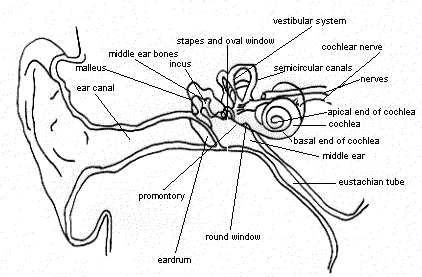|
Over
one million Australians have some kind of hearing loss.
Of these over 50 000 have severe or profound deafness
and can hear virtually no sound. Three in every 1000
children are born with a hearing loss or develop a loss
before learning to speak.
How
does the ear work?

Diagram of the ear
Courtesy: Department of Otolaryngology, The University
of Melbourne
Hearing
occurs when sound waves are collected by the ear as
vibrations which are passed to the cochlea where they
are transmitted as electrical signals which are then
decoded by the brain.
The
ear has three parts, the external, middle and inner
ear. The external ear is made up of the pinna (the fleshy
part on the side of your head) and the ear hole or ear
canal. The pinna collects the sound and directs it into
the ear canal towards the ear drum membrane.
The
ear drum is the start of the middle ear, and vibrates
when sound hits it. The vibrations from the ear drum
are passed onto three small bones (the smallest in the
body) called the ossicles. These middle ear bones amplify
the sounds and pass them into the inner ear.
The
inner ear contains the shell like structure called the
cochlea, which transfers the vibrations along the auditory
nerve using electrical signals that are perceived by
the brain. The "nerve fibres at the entrance to
the cochlea typically respond to high frequencies of
sound, while those at the end of the cochlea respond
to low frequencies". (Cochlear, 2001)
Hearing
loss
Deafness or hearing loss occurs when something goes
wrong with some part of the ear. It is detected when
a listener is unable to receive or interpret sounds.
There are two basic types of deafness:
- conductive
- sensori-neural.
Conductive
deafness occurs when sound is prevented from reaching
the inner ear. This can happen when the ear drum is
perforated by an infection or the ossicles become stiff.
In this case the inner ear is normal and the sound is
prevented from getting to the cochlea.
In
sensori-neural deafness there is a problem with either
the cochlea or the transmission of the signals to the
brain once they have left the cochlea. This can be caused
by exposure to loud sounds such as music or construction
sites.
The
cochlear implant system can help people with sensori-neural
deafness.
For
more information about hearing loss visit
Better
Hearing Australia,
a support organisation for people with hearing loss.
National
Occupational Health and Safety Commission
If you listen to loud music you might want to check
Hearing
Education and Awareness for Rockers.
For
more information about hearing:
NOVA:
Science in the News: includes info on the mathematics
of hearing.
Cochlear
Ltd
|